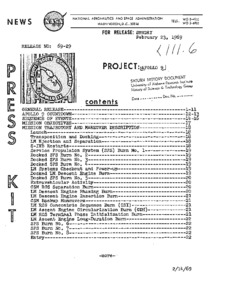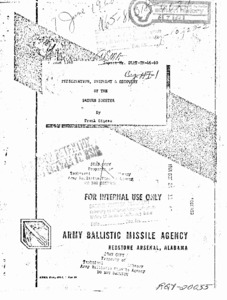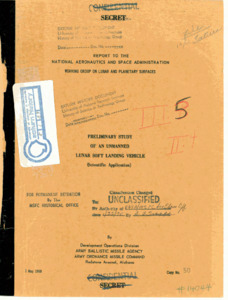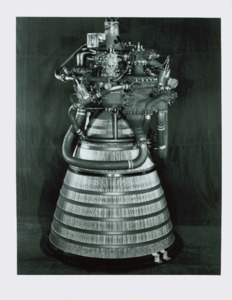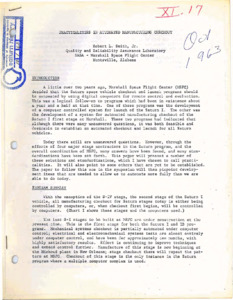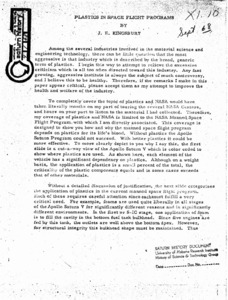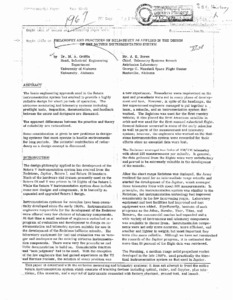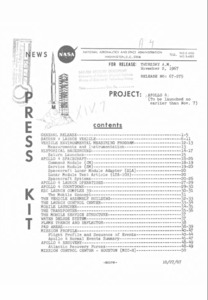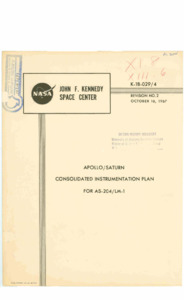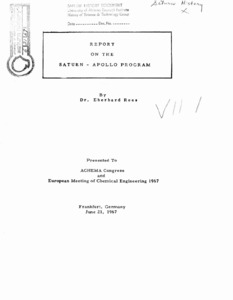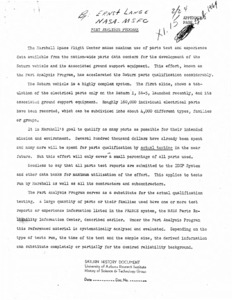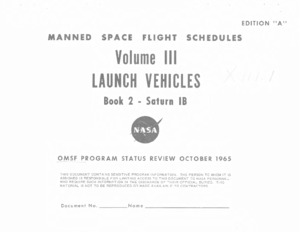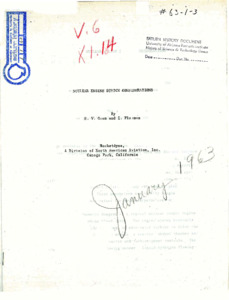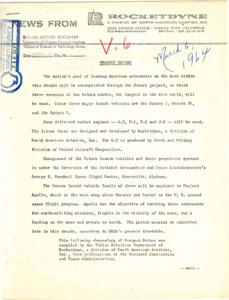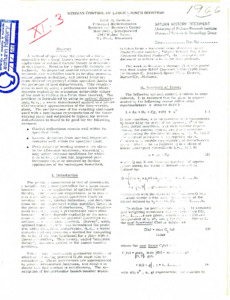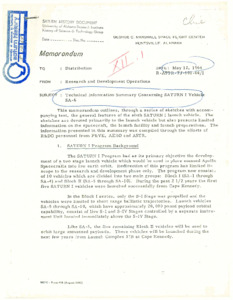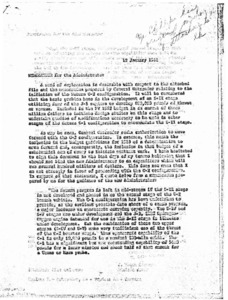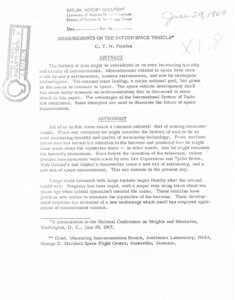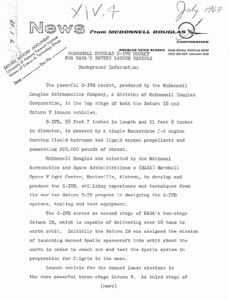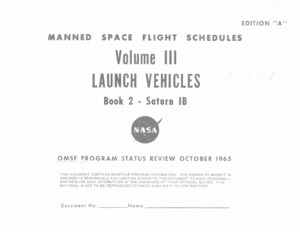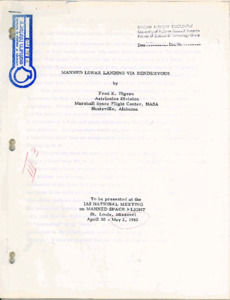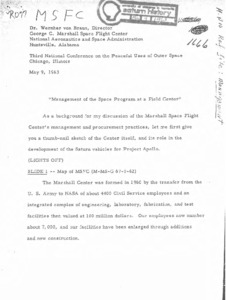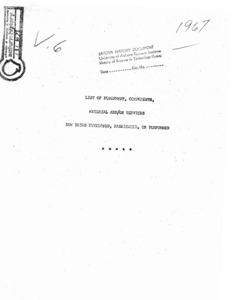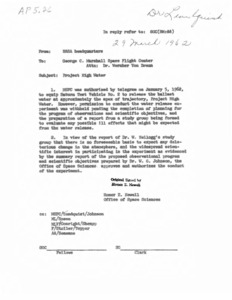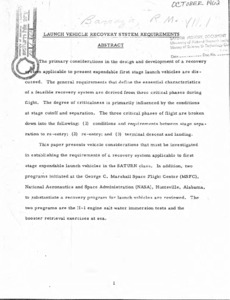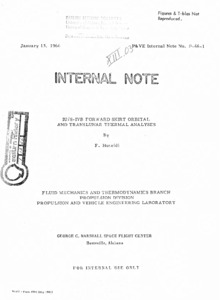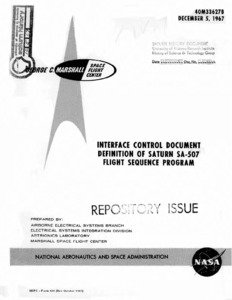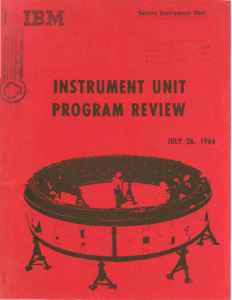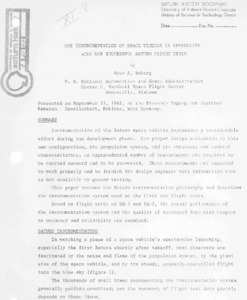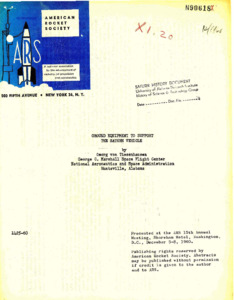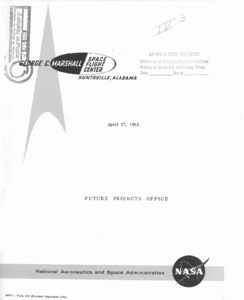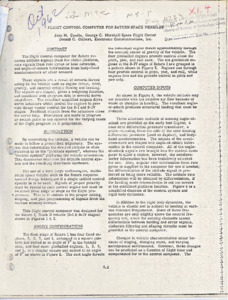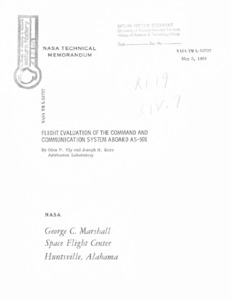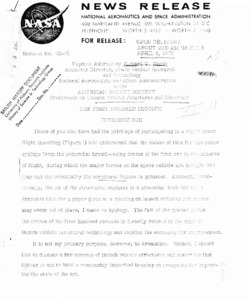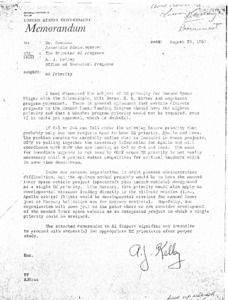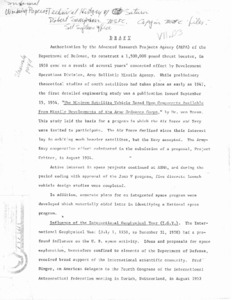
Browse Items (175 total)
Sort by:
-
"Apollo 9 carries lunar module."
Press release surrounding the Apollo 9 rocket and its crew prior to launch. -
Preservation, shipment & recovery of the Saturn booster.
The purpose of this report is to present the shipping and recovery procedures for the Saturn booster. -
"Preliminary study of an unmanned lunar soft landing vehicle (Scientific Application)."
Report to the National Aeronautics and Space Administration Working Group on Lunar and Planetary Surfaces. -
"Pratt & Whitney Aircraft RL10 liquid hydrogen rocket engine."
Photograph of a liquid hydrogen rocket engine. -
"Practicalities in automated manufacturing checkout."
This paper presents a number of solutions to a number of unanswered questions regarding the Saturn projects. -
"Plastics in space flight programs."
Article aimed at improving the NASA's ability to complete its projects." -
"Philosophy and practices of reliability as applied in the design of the Saturn Instrumentation System."
The basic engineering approach used in the Saturn instrumentation system has evolved to provide a highly reliable design for short periods of operation. The airborne measuring and telemetry systems including preflight tests, inspection, documentation, and feedback between the users and designers are discussed. The apparent differences between the practice and theory of reliability are rationalized. Some consideration is given to new problems in designing systems that must operate in hostile environments for long periods. The potential contribution of redundancy as a design concept is discussed.; This paper is concerned with the airborne measuring and telemetry systems; it does not attempt to treat the entire Saturn instrumentation system which consists of tracking devices including optical, radar, and Doppler, plus television, film cameras, and a myriad of instruments connected with factory checkout, ground test, and launch. -
"Apollo 4 press kit."
The flrst flight test of the Apollo/Saturn V space vehicle is scheduled for launch from the Natlonal Aeronautics and Space Administration's John F, Kennedy Space Center, Fla., no earlier than Nov. 7. The mission is designated Apollo 4. -
"Apollo/Saturn consolidated instrumentation plan for AS-204/LM-1."
This report represents the consolidated instrumentation plan for employing optical and electronic data acquisition systems to monitor the performance and trajectory of the Apollo/Saturn 1B vehicle, AS-2 04/LM-1, during powered flight. Telemetry and electronic tracking equipment on board the vehicle, and data acquisition systems monitoring the flight are discussed. Flight safety instrumentation and vehicle data transmission are described, and geophysical information is provided. This plan reflects the general instrumentation coverage requirements set forth in the NASA Program Support Requirements Document (PSRD) for Apollo/Saturn 16, and the commitments of Eastern Test Range (ETR) Operations Directive (OD) No. 4206,dated 15 August 1967. This plan is not intended to conflict with or to supersede either document. The information presented in this document reflects planning concepts developed prior to October 1, 1967. -
"Report on the Saturn-Apollo program."
Presented to ACHEMA Congress and European Meeting of Chemical Engineering 1967, Frankfurt, Germany, June 21, 1967 by Dr. Eberhard Rees.; Includes slide numbers. -
"Part analysis program."
Includes carbon copy of letter sent to David L. Christensen from Ernst Lange regarding the Part Analysis program. -
"Organization of a countdown"
The Organization of a Countdown was developed over 8 years of missiles and space systems testing at the Douglas Aircraft Company, Sacramento test Center. The experience on which this study was based includes the Thor development and acceptance testing, Titan I second stage engine development testing, Development of liquid hydrogen handling techniques, Saturn S-IV and S-IVB development and acceptance testing. The intent of this paper is to examine the static test countdown organization and discuss the need for a systematic method to organize a countdown. -
"Manned space flight schedules. Vol. III, launch vehicles : book 2, Saturn IB."
OMSF Program Status Review August 1965.; Edition "A" -
"Nuclear engine design considerations."
The intent of this paper is to examine the static test countdown organization and discuss the need for a systematic method to organize a countdown. -
"News from Rocketdyne : Project Saturn."
Press release exploring the rockets and projects of the Saturn project. -
"Minimax control of large launch boosters."
Keith D. Graham is principal mathematician, Systems and Research Center, Honeywell, Inc., 2345 Walnut Street, St. Paul, Minnesota.; Work done under NASA contract NAS 8-11206 from the George C. Marshall Space Flight Center.; ABSTRACT: A method of specifying the gains of a linear controller for a large launch booster using a new application of optimal control theory is described in this paper. Results for a specific example are included. An important control requirement is to maintain cost variables (such as bending moment, engine gimbal deflection, and lateral deviation from desired trajectory) within specified limits in the presence of load disturbances. This requirement is met by using a performance index which depends explicitly on maximum achievable values of the cost variables in a finite time interval. -
"Memorandum : technical information summary concerning Saturn I vehicle SA-6."
This memorandum outlines, through a series of sketches with accompanying text, the general features of the sixth SATURN I launch vehicle. The sketches are devoted primarily to the launch vehicle but also presents limited information on the spacecraft, the launch facility and launch preparations. The information presented in this summary was compiled through the efforts of R&DO personnel from P&VE, AERO and ASTR. -
"Memorandum for the administrator."
Very poor photocopy. Memorandum requesting additional information regarding a file attached to this one. -
"Apollo 8 Mission (AS-503) : memorandum to A/Acting Administrator from MA/Apollo Program Director."
Memorandum discussing the first manned Saturn V flight, its purpose and when/where the launch will take place. -
"Measurements on the Saturn space vehicle."
The history of man might be considered as an ever increasing quantity and quality of measurements. Measurements related to space have been made by early astronomers, modern astronomers, and now by aerospace technologists. The manned lunar landing, a major national goal, has given us the means to measure in space. The space vehicle development itself has made heavy demands on instrumentation; this is discussed in some detail in this paper. The advantages of the International System of Units are mentioned. Some examples are used to illustrate the future of space measurement. -
"McDonnell Douglas S-IVB rocket for NASA's Saturn launch vehicle."
Press release detailing how a rocket is the top stage of both the Saturn IB and Saturn V launch vehicles. -
"Manned space flight schedules. Vol. III, launch vehicles : book 3, Saturn V."
OMSF Program Status Review October 1965.; Edition "A". -
"Manned space flight schedules. Vol. III, launch vehicles : book 2, Saturn IB."
OMSF program status review October 1965.; Edition "A". -
"Manned Lunar Landing via Rendezvous."
Paper to be presented at the IAS National Meeting on Manned Space Flight. Focuses on operations leading to injection of the space craft into the lunar transfer trajectory. -
"Management of the Space Program at a Field Center."
Transcription of a presentation from Wernher von Braun discussing the roles of the space vehicles in the Apollo project. -
"List of Equipment, Components, Materials, and/or Services Now Being Developed, Fabricated or Performed."
Lists of different parts of rockets. -
"Project High Water."
Letter to Wernher von Braun from NASA headquarters regarding Project Highwater and how it was withheld. -
"Launch Vehicle Recovery System Requirements."
The primary considerations in the design and development of a recovery system applicable to present expendable first stage launch vehicles are discussed. The general requirements that define the essential characteristics of a feasible recovery system are derived from three critical phases during flight. The degree of criticalness is primarily influenced by the conditions at stage cutoff and separation. The three critical phses of flight are broken down into the following: (1) conditions and requirements between stage separation to re-entry; (2) re-entry; and (3) terminal descent and landing. -
"IU/S-IVB Forward Skirt Orbital and Translunar Thermal Analyses."
This report determines the maximum and minimum solar and terrestrial thermal energy incident and absorbed by Saturn IB/V vehicles in earth orbit and translunar travel. The influence' of this external energy on the Instrument Unit Thermal Conditioning System performance, and consequently its adequacy to maintain the electronic packages at acceptable temperature limits is ascertained. Conclusions are: a) Methanol/water coolant temperature will deviate from 111 specifications only during translunar cold flights. However, adequate thermal conditioning of the electronic equipment would still be maintained. b) Instrument Unit missions exceeding 6 1/2 hours, or electronic packages heat dissipation magnitudes lower than 3 kw or higher than 8.5 kw, should be reviewed to ascertain thermal compatibility. -
"Interface Control Document Definition of Saturn SA-507 Flight Sequence Program."
The purpose of this document is to define the flight sequence events, time bases, stage switch selector channel assignments, LVDA Discrete Outputs, Inputs and Interrupts for the Saturn SA-507 & Subs vehicles. Special requirements and restrictions defined in this document will be imposed on the Marshall Space Flight Center and its contractors as applicable, to insure the proper functioning of the equipment in the various stages for required vehicle timing and sequencing to occur as outlined in this Interface Control Document (ICD). -
"Instrument Unit Program Review : Saturn Instrument Unit."
Handwritten names and phone numbers on the first page. Apollo / Saturn Team. -
"The instrumentation of space vehicle in connection with the successful Saturn flight tests."
Presented on September 21, 1962, at the Eleventh Tagung Der Deutchen Raketen - Gesellschaft, Koblenz, West Germany. Instrumentation sf the Saturn space vehicle represents a considerable effort during the development phase, for proper design evaluatian of this new configuration, its propulsion system, and its structure and control characteristics, an unprecedented number of measurements are required to be carried onboard and to be recovered, These measurements are expected to work properly and to furnish the design engineer with information that is not available by ground testing, -
"Ground Equipment to Support the Saturn Vehicle."
With the advent of the first large space vehicle, the SATURN, the ground support equipment and launch facility designer is faced with the necessity of conceiving and building an unprecedented launch system concurrent with the vehicle development. The paper intends to present a comprehensive picture of the problems involved and how they are solved. It follows the SATURN through the various modes of operation such as transportation over land and water, checkout, handling and erection, propellant loading, and describes the facilities at the launch site. -
"Future Projects Office."
The purpose of this brochure is to give interested readers, outside as well as within the agencies of the U.S. Government, information on the mission and activities of the Future Projects Office, George C. Marshall Space. -
"Flight Control Computer for Saturn Space Vehicles."
The flight control computer for Saturn receives attitude signals from the stable platform, rate signals from rate gyros or lead networks, and angle-of-attack information from body-fixed accelerometers or other sensors. -
"Flight Evaluation of the Command and Communication System Aboard AS-501."
The first test of the command and communications system, a unified frequency S-band system, aboard AS-501 was successful. Compatibility of this system with the MSFN/USB sites was established. The onboard transponder and antenna system including antenna switching performed as predicted. The command performance was excellent with 5747 valid commands received onboard out of 5748 commands transmitted. Data reduction problems prevented a complete analysis of the tracking data. Telemetry system performance was satisfactory with a measured bit-error-rate of 4 x10-5 while over the Ascension Island station. This flight provided valuable data which can be used to define vehicle to-ground-station interfaces, to establish attitude constraints during translunar injection, and to improve operational procedures. One more test as successful as the AS-501 test would qualify the system as operational.; May 3,1968. -
"First Hundred Seconds."
Keynote address at National Aeronautics and Space Administration to the American Rocket Society Conference on Launch Vehicle Structures and Materials. Speech focuses on problems facing the structure of Saturn rockets and other space vehicles. -
"Dynamic Environments of the S-IV and S-IVB Saturn Vehicles."
The vibration and acoustic environments of the S-IV and S-IVB Stages of the Saturn vehicle are summarized. A brief review of techniques used to predict the dynamic environments of the S-IV and S-IVB vehicles is presented. This review includes discussions on the prediction of rocket exhaust noise, boundary layer noise, sinusoidal vibrations, and random vibrations for the S-IV and S-IVB vehicles. In addition, sine-random vibration conversions are given. -
DX priority: memorandum.
Memorandum discussing the priorization of various nlunar landing vehicle projects. -
"Technical History of Saturn."
Draft of working paper. Typed with handwritten notes (title and author) and pages. Copy in MSFC files noted on first page.
